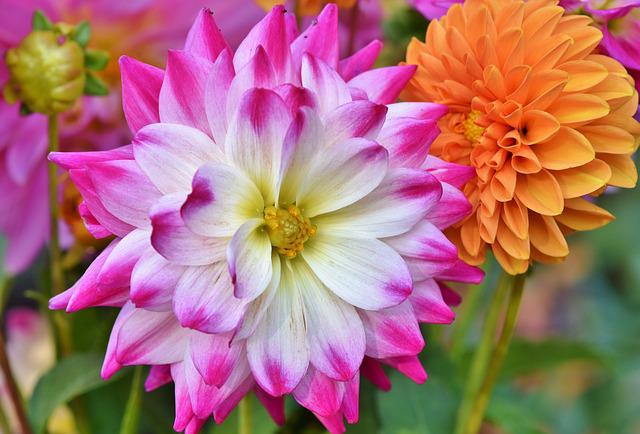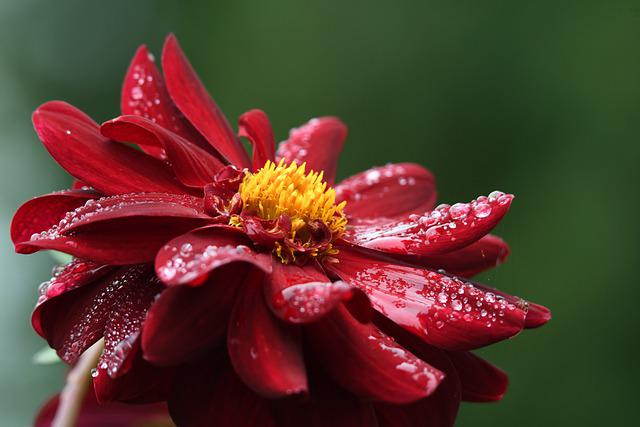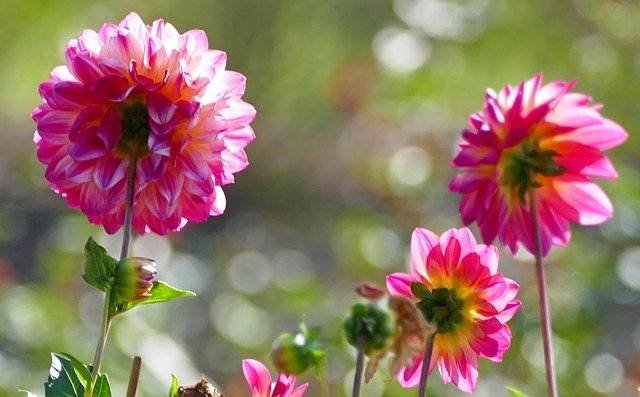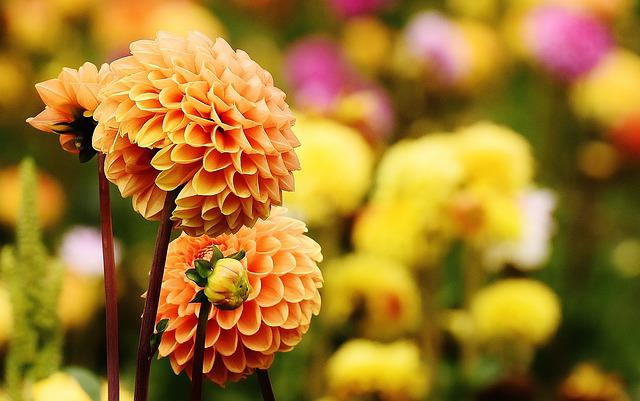Dahlia Care In Pots: 10 Great Tips for your Container Grown Dahlia

Dahlias are one of the most versatile plants you can grow in your home. Not only are they beautiful plants that add a splash of color to any room, but they are also versatile enough to be treated as houseplants. However, before you can start dealing with dahlias in pots, you first need to understand how to take care of them. In this article, we will teach you everything you need to know about dahlia care in pots. From watering habits to fertilization, we’ll cover everything!
Table of Contents
Will Dahlias Grow in Pots?
Dahlias will grow in pots, but they should be planted in well-drained soil and given plenty of water. They are medium to tall perennials that need about 1 inch of moisture per week. Dahlias prefer full sun but can handle some shade if necessary.
They are easy to care for and usually bloom from late summer until early fall. You’ll want to deadhead (remove the flowers) when they start to fade for best results. Harvests can range from 2 to 6 inches long, so it’s important to pick them when they are at their peak color!
10 Care Tips for Dahlia Grown in Pots
Choosing Pots
Before purchasing dahlias, examine your container stockpile thoroughly. Separate the ones you believe to be worthy dahlia containers from the rest.
If you are dissatisfied with your current options, consider visiting an estate or garage sale. Both are excellent resources for low-cost container garden treasures.
Disinfection is always the top priority for any container that has been recycled. Clean the pots thoroughly with a solution of 9 parts water to 1 part bleach after removing all traces of last year’s soil. Carefully rinse and allow them to dry.
Whether you’re using existing pots, incorporating new pots into the patio design, or starting from scratch, you should seek out containers that meet the following criteria:
- Width: Dahlia tubers require ample space for expansion and soil that is never completely dry. Choose a container at least 12 inches wide for the smallest dwarf varieties. For plants that exceed 1 foot in height, 16 to 24-inch containers should be used.
- Height: Dahlia pots should be at least as deep as they are wide, and ideally, they should be deeper. Since the tubers will be planted about 6 inches below the surface, a taller pot will give them more room to drain and make it less likely that water will pool. This is especially important for tall dahlia varieties because their roots will grow even deeper.
- Material: Clay or terra cotta pots have holes in them, letting air flow through and making water evaporate faster. Only use clay pots if you’re going to water them regularly. Plastic and cement containers will help keep the temperature even, but don’t overwater them because they will hold more water. Dahlias can grow well in wood planters if you know they haven’t been treated with chemicals and you water them regularly. Metal drums and tubs are popular in gardens right now, but they can get very hot on hot days. You should only use these pots if they are wide enough to keep the roots from getting too hot.

Drain the Water
Check the drainage holes in your pots to make sure water has a way to get out. Standing water is the quickest way to kill your dahlias because it makes them susceptible to root rot and fungal diseases.
If you use recycled containers, ensure the holes are clean and have a diameter of between ¼ and ½ inches. Oklahoma State University Extension suggests making drainage holes on about 20% of the bottom surface of your container. To get this ratio, use this as a rough guide and add more holes with the right size drill bit.
In new containers, drainage holes may occasionally need to be punched out with a hammer and screwdriver or may have markings on them indicating where they should be drilled.
You may have heard that the best way to ensure proper drainage is to fill drainage holes with stones or pieces of broken flower pots, but seasoned gardeners will advise you to skip it. Rocks can occasionally create more issues than they resolve, and gravel will create a system of stratification that hinders drainage. Pots with the right growing medium and adequate watering will drain without losing soil.
Select the Correct Cultivar
The height of dahlias varies from 10 inches to 7 feet, and the width of their blooms varies from 2 inches to 12 inches. Others will only send up one or two spikes, while others will have bushier habits with multiple flower points. Knowing what you’re planting will help you select the ideal container, create an effective maintenance schedule, and get the desired result.
Dahlias can be classified as dwarf, midsize, or giant in terms of height. When designing a balcony or patio garden, your decision-making process may be influenced by the available containers or the space constraints. Your intended use, such as pollinator stimulation, or flower cutting, may also have an impact. Before buying, consider these factors and buy cultivars that meet your needs.
It’s best to think about small and medium dahlia cultivars for your patio garden unless you’re working with a mega-sized container. Consider the scale; a tall, dinnerplate-sized dahlia in a small container will look ridiculous and may even topple over. When choosing which dahlias to try, keep bloom heights roughly in line with pot heights.
Small
Dahlia variety “Fresco” is a good dwarf to try in smaller pots because it has a wide range of colors and only grows to a height of 1 foot.
‘Figaro’ has a compact, showy habit and numerous double blooms in various colors.
With upright stems reaching 18 inches and dark foliage, “Mignon” has single red, orange, pink, yellow, or white flowers.
Medium
Dahlias named “Happy Single First Love” have petals with red centers and apricot tips. With a 2-foot circumference, the foliage is dense and dark.
This 1-2 foot cultivar, “Impression Fabula,” is a lovely option for medium-sized pots thanks to its elegant pink petals and white tips.
Consider ‘Art Deco’ for prodigious patio blooms; it has 4-5 inch coral-pink flowers on 2-foot stems.

Sun Requirement
Dahlias are a sun-loving genus, so place your containers somewhere. They will receive at least 6 hours of direct sunlight each day. In warmer climates, morning sun is preferred to afternoon sun. If you can’t protect them from the morning sun, make sure to water them regularly and provide some shade if you can in the afternoon.
Dahlias are a sun-loving genus, so place your containers where they will receive at least 6 hours of direct sunlight each day. In warmer climates, morning sun is preferred to afternoon sun. If you can’t protect them from the morning sun, make sure to water them regularly and provide some shade if you can in the afternoon.
Equally Water
Dahlias should never be completely dry or soaked; irrigation requirements will vary depending on the region. Gardeners who grow dahlias in containers frequently find this their biggest challenge.
Insert your index finger two inches into the soil to check the soil each day, if possible. It should always be moist, but not muddy or sopping wet. Using a watering can or drip hose made for containers, water the roots of your dahlias rather than the foliage.
Don’t Overfertilize
Your potting mix was probably amended with early growth fertilizer, so your dahlias shouldn’t need any more fertilizer for about another month. If a booster was not added, you could begin by using a nitrogen-rich fertilizer designed to produce robust stems and leaves.
Dahlias will benefit from a fertilizer with more potassium and phosphorus than nitrogen once they are established, and the goal is to produce stunning blooms. Choose products with a ratio of 5-10-10 or the equivalent ade for blooms, and use them per the instructions. Dahlias will continue to bloom well into the fall, so you can repeat the process 30 days later, but that should be your final application. Soon, dahlias will start preparing for dormancy.
Proper Planting
Dahlias should be planted in a potting mix designed specifically for container gardens to ensure proper drainage and nutrient distribution. Combining garden soil with the other media will not need to combine garden soil because the two will drain at different rates. Similarly, there is no need to combine aerating materials like bark, sand, pearlite, etc., because they will probably already be in the bag.
Dahlias need a pH level of about 6.5, so pay attention to the mix’s acidity and note any fertilizer it contains so you can feed dahlias correctly later in the season.
Fill the bottom third of your container with soil. If green shoots have not yet appeared, place the tuber on top with its eyes pointing up. As soon as the root is centered, add a layer of potting soil about an inch thick. Mist the soil to keep it wet but not soaked until the shoots have broken through the top of the container and it is about two inches below the rim.
Dahlias that are established and already protruding above the rim of your pot should be planted using the same technique without layering. Your dahlia stems should be completely covered in potting soil, leaving a two-inch space at the top for watering.
Stake to Stability
Dahlias that are shorter in stature won’t require staking, but anything that will reach a height of more than one foot needs to be supported. This is a crucial protective measure because the worst enemies of dahlia can be strong winds and careless kids.
When planting, choose a cane, stake, or cage the same length as the mature height of your variety and bury it firmly in the ground about 4 inches from the root. Use garden ties or cloth strips to fasten stems to the stake, and check on blooms frequently to keep an eye on new growth. Regularly assess whether your ties are preventing growth and make necessary adjustments.
Pinch and Prune
If you want your flowers to be closer together, you could pinch or prune the tops of your dahlias when they have three or four leaves. Although dahlias are typically vertical, this simple gardening technique will promote more side shoots and a rounder habit.
Remove the top third or fourth of the plant’s leaves with a small pruning tool. To encourage even bushier dahlias, you can repeat this procedure in a few weeks.
On the other hand, you can use pruning shears to remove smaller side buds from young plants to create a more solitary, upright habit with larger blooms if you want one or two large, showy dahlias to light up your balcony.
You must remove dying blooms every few days to keep your dahlia pots vibrant and cheery throughout the season. This process prompts roots to focus their energy on producing new blooms rather than dispersing seeds.
Use your fingers or a tiny pruning tool to remove spent blooms from your dahlia plants just above a clump of leaves in the proper deadheading technique. Remember that a dahlia plant has rounded new buds and pointed spent blooms. Knowing this can help avoid a maintenance mistake that deprives your plants of their upcoming flower heads!
Overwintering
It’s time to bring your dahlias inside for the winter once the first frost appears or when their leaves start to turn brown. In colder hardiness zones, overwintering is usually necessary. One advantage of growing dahlias in containers is cutting them down. All you need to do to bring your containers inside at the appropriate time.
Once a month, give them a cup of water and keep them in a cool, dark place that doesn’t freeze but doesn’t get too hot. You can relocate them to a sunny area when spring returns so you can help them emerge from dormancy.
The tuberous roots of your dahlias may be crowded in the pot after a long growing season, which will likely necessitate a division in spring. This is one disadvantage of this lazy gardener’s overwintering method. Most of us simply don’t have the space for heavy, dirt-filled pots because they are typically bulky.

